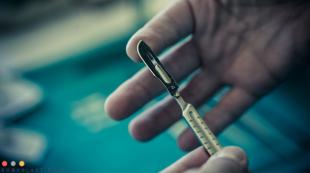Methods for fixing plastic wall panels. Wall decoration with plastic panels: independent decoration of the walls of the room with plastic panels
The modern market offers a huge number of varieties, sizes and design options for PVC panels, so they can be matched to any interior style. PVC panels are inexpensive, quickly mounted, operated for a long time, and most importantly, they will help to equip a unique, unlike any other room design. How to fix plastic panels to the wall: on glue, on screws, on the crate? Which panels to choose and which installation method to prefer, we will analyze all these issues in detail in our article.
Why PVC bathroom panels have become the number one competitor to tiles? It's all about ease of installation. Put tile even on the most even basis, it is beyond the power of a person who has never done this. You will need the services of a specialist to level and strengthen the base, mark the wall and lay out the tiles row by row, observing the levels and width of the tile joint. In addition, the cutting of tiles itself, if necessary, requires special tools and certain skills.

With PVC panels everything is much easier. They have a lot of advantages:
- Light in weight: their transportation to the house and installation do not cause any difficulties.
- Exist several mounting methods from simple wall stickers to purlin systems, each of which can be handled even by a layman.
- Panels biologically sustainable and during operation, the appearance of fungus on them is excluded.
In addition, there are such advantages plastic products, as moisture resistance, hygiene, duration of operation and inexpensive cost. Of course, they also have their own characteristics. For example, despite the presence of stiffeners in the design of the product and the thickness of the plastic, which is quite large for some manufacturers, the panels are quite brittle material. and with an accidental strong point impact, they can break through. Therefore, when buying, you need to choose the most durable products of European manufacturers.
However, if the lining good quality, then when bathing, for example, you can rely on it as much as you like: it has sufficient flexibility and elasticity to support the weight of a person.

When choosing products, you should look at such specifications, as:
- plastic thickness (the more, the more reliable);
- the presence and number of stiffeners;
- when looking at artificial lighting on the front plane, transverse ribs should not be visible;
- the surface must be intact, undamaged, not scratched, the film on the front plane must not be damaged;
- plastic from the ends should not be with burrs and microcracks.
There are several types of PVC panels, differing in size and other parameters.
Table 1. Types of PVC panels.
| Name | Peculiarities | Dimensions |
|---|---|---|
| Ceiling | Thinner thicknesses up to 5 mm | |
| Wall | Thicker and tougher up to 10mm thick | width 15-50 mm, length 90-300 mm |
| Rack | Narrow planks with shaped edges, similar to lining, have a thorn-groove locking connection | width 13-50 mm, length 90-300 mm |
| leafy | Large rectangular sheets with a relief or pattern on the outside | width 50-122 mm, length 30-98 mm |
| Tiled | Tile | width 30-98 mm, length 30-98 mm |
| Sandwich | Double-layer, with a heat-insulating layer, the thickness can reach 4 cm | width 90-150 mm, length 300 mm |
In width, standard wall panels are most often found 25cm and 37cm, length - 2700cm, 3000cm. Different manufacturers may produce products of different sizes. The difference in price depends on various factors: the quality and thickness of the plastic, the type of decor printing, its complexity, etc.
Polyvinyl chloride panels are divided into several types according to their coating. They are:
- monochrome;
- colored, with a dye added to the mass;
- mirror;
- with an image pasted on a thermal film;
- with a pattern applied by offset;
- with one image spaced into several panels, forming a panel.
According to the method of connection, the products can be seamless and with a recess. Of course, when joining seamless panels, the seam still remains visible, but hardly noticeable. If the products are chamfered, then the seams are more highlighted and create a certain geometry of the room.
In addition, a wide range of accessories for fastening elements is offered: start and F-shaped profiles, internal and external corners, joint profiles, skirting boards. The use of fittings allows you to give an aesthetic appearance to the joints, and of course it is used for a more reliable and simple fastening.

Find out what types, and also check out step by step instructions for finishing, in a special article on our portal.
Prices for popular finishing wall panels
Wall panels
Mounting
To carry out the calculation, you first need to determine the direction of installation. Products can be attached horizontally and vertically. Vertical placement is preferred for small spaces such as hallways, kitchens, and bathrooms. With this method of finishing, the ceiling visually rises due to vertical lines. Horizontal installation is more often used for finishing spacious rooms, for example, at camp sites, in hostels. It resembles a traditional horizontal finish, especially if the panels are matched, for example, under a tree.

Panels can be fixed in three ways:
- on any adhesive composition;
- on self-tapping screws;
- on the crate.
The first method is the easiest, simplest and fastest, but only applies if the base is sufficiently level. The second is also not particularly difficult, but requires skill in handling a screwdriver. In this case, the panels can be dismantled over time and moved to another location. The method of fastening to the crate is the most durable, time-consuming and capital. Thus, the cladding can be firmly mounted on uneven surfaces.

The selected mounting option does not affect the order of events when mounting the plates directly:
- fittings are installed: initial and finishing strip, internal and external corners;
- fittings are installed along the openings;
- the panel is inserted with a narrow shelf into the fastening element. Fastened from the side of a wide shelf with self-tapping screws. Elements must be mounted tightly;
- the final panel must be squeezed between the one in front of it and the finishing element of the row. The excess can be trimmed neatly along with a knife;
- joints with the ceiling are covered with ceiling, joints with the floor - with floor plinths.
How to glue panels
Bonding - the easiest way finishing the room with panels, which is allowed either in the event that when the wall is perfectly flat or when the leased premises are being renovated according to the principle and so it will do, clean and okay. It will be quite difficult to dismantle such a finish in the future and it certainly will not be possible to use it for re-assembly.
The panels are glued to a flat or slightly uneven base. Previously, to improve adhesion, it is necessary to remove and clean out all the bumps and weak layers of the previous finish. Then plaster and putty uneven places. Then prime the surface to improve adhesion. The finished base for gluing the cladding must be even, dry, clean.
Apply the adhesive to the wall, spread it evenly with a notched trowel and gently press the panel against the wall. The duration and force of pressing usually depend on the adhesive and are indicated on the packaging or in the instructions for use. Also apply glue to the next panel, then it should be carefully docked with the previous one and pressed to the base. Thus, you can quickly get a beautiful decorative coating.
Video - Installation of PVC panels with glue
As for the adhesive for panels, modern manufacturers simply offer huge selection adhesive compounds. You can list the most popular:
- quality liquid nails;
- liquid nails and Titan Wild glue;
- Emfikol 34012A;
- Kleiberit 636.
Prices for liquid nails
Liquid Nails
The above adhesives are resistant to high humidity and temperature fluctuations. glued on them facing materials will last throughout the life of the product.
Advice! If there is a choice, it is better to choose the most quickly setting adhesives - for example, liquid nails. Then you don't have to wait for a while until the first panel grabs to start gluing the second one.
Installation of PVC panels on self-tapping screws
This mounting method also includes a sufficiently level base. Although the requirements for the surface condition are less than when working with glue. No need to output greasy spots from the wall and treat it with a primer to increase adhesion. However, to improve the quality of work and increase the speed of installation, a screwdriver is required. However, today screwdrivers can be bought even for one and a half thousand rubles, so this installation method can be called quite budgetary.
As for self-tapping screws, you can opt for wood screws with a wide notch. Length 16 mm will ensure proper fixation to the wall. If finishing is planned bathroom, you should opt for galvanized, that won't rust during operation. Do not choose self-tapping screws with a wide hat, it can interfere with docking.
The process itself is extremely simple. From the inside, the screws are screwed into the bottom of the lock, where they will not interfere with the fixation of the next panel. The next strip is inserted into the lock, pressed and fastened with self-tapping screws from the inside. All subsequent parts are attached in the same way.

Attention! Be sure to check where the wiring goes in the wall. To do this, you can use inexpensive devices such as indicator screwdrivers, signaling devices or metal detectors.
Prices for popular models of screwdrivers
Screwdrivers
How to fix panels to an uneven wall on a crate - step by step instructions
If the wall is very uneven, and living in the apartment is supposed to be long, you can’t do without crates. There are 3 types of crate systems: wooden, metal and plastic. Wooden - this is an option for the most extreme case. The tree is not suitable for the bathroom - it will swell from moisture, for the same reason you should not use it on the loggia. So the best way- galvanized profiles for plasterboard width 40mm.

The only drawback of the traditional crate fastening is that it eats 3-4 cm of usable area at each wall. But under it, you can lay communication cables, as well as make a soundproof layer in the apartment or a heat-insulating layer on the loggia.

A good variety of a convenient and easy-to-assemble crate system is plastic mounting strips and plates - kleimers. This is special system fasteners designed for PVC cladding. Fastening is carried out as quickly and simply as possible: the plate snaps into the groove on the profile with clamps. No other fastener is used. If necessary, such a finish is instantly disassembled: just pry it with a screwdriver. Installation of the entire cladding in a room of 15 squares with such a system will take no more than a day.
The advantages of plastic crates are obvious. Firstly, in case of damage to one panel, it can be pulled out and replaced for this no need to disassemble the whole structure. Secondly, if the house is shrinking, or if it Vacation home, as well as during seasonal shifts cladding will retain its solidity. Thirdly, such a crate eats only 1 centimeter from every wall.

For bathrooms and kitchens, the best option is a ready-made plastic crate system sold in construction departments. It does not deform due to high humidity and temperature fluctuations, does not rot or crack. Galvanization is also a great solution to the problem. It is also permissible to use wood blocks, but before starting work, they must be treated several times with special impregnations from decay.
Let's take a step-by-step look at how to mount the crate:
Step 1. We clean the wall from crumbling old finishes. You don't need to level it.

Step 2 We process the surface of the wall with antifungal compounds.

Step 3 We mark the places for the slats of the crate structure. They should be perpendicular to the PVC panels. If they are mounted vertically, then the crate is mounted horizontally. The spacing of the bars should be 30-35 cm.

Step 4 We fasten the bars at the beginning and at the end of the wall, around openings, niches and other structural elements of the room. Then the rest. The whole system is attached to the dowels. AT concrete put 6*40mm, in brick 6*60mm in increments of about 60cm.

Step 5 We align the crate with a plumb line in one plane. To do this, at first the fasteners are not completely twisted, and if necessary, thin plywood is stuck under the planks to the required level. After alignment, the fasteners can be tightened. For attachment, you can use hangers for plasterboard. With them it is easier to level the surface of the crate.

Step 6 If the system is assembled from plastic elements, it is necessary to check their perpendicularity to the PVC panels, otherwise there is a risk that the locks will not snap into place. It will be more convenient to work with a plastic crate if wooden bars are installed around the perimeter of the entire wall being trimmed along the thickness of the guides.

Prices for building levels
Building levels
Now you can consider how the panels are attached to the crate:
- Starting and ceiling plinths and fastened with appropriate fasteners to the system. The result is a frame. It is necessary to strictly check the verticality and horizontality of this frame, and then the plane of the cladding in terms of level, since even a millimeter deviation can cause a blockage in the future.
- Elements are cut to length with a hacksaw. A protruding spike is cut off from the first panel, then the cut side is inserted into the corner, and the edges are tucked into the profiles. The bar is driven all the way and fixed to each crossbar.
- Joining subsequent panels.
- The latter is cut to width and inserted into profiles.
Video - Installation of PVC panels on the crate
Note! Some craftsmen prefer to work without corner profiles. The panel that goes into the corner can be cut from the back and gently bent so as not to break. This usually succeeds the first time, since plastic for the manufacture of panels is used quite flexible and elastic. From the front side, such a fold will look nice and neat.
Features of fastening in different rooms
Pay attention to the article - where we analyzed interesting options installation of panels in the restroom.
The following features of the finishing device in different rooms can be distinguished:
- In the bathroom and high humidity and temperature changes often occur, so it is better to take a crate system made of plastic or stainless steel. If the wall is without special bumps and pits, you can glue the cladding on liquid nails or even mounting foam. Mounting on self-tapping screws (also made of stainless steel) is acceptable.
- For decoration loggias or balconies it is better to take sandwich panels and lay them on the crate, under which you can place a layer of thermal insulation.
- For decoration living rooms take decorative panels with patterns, drawings or with a 3D effect. Installation should be carried out taking into account the condition of the walls. If there are a lot of wires in the room, it is better to use a crate for which they can be hidden. In the rooms, you can arrange a more economical wooden crate, since the humidity drops are small here.
- For decoration rooms country houses , used only in the season, as well as terraces and verandas, you should use any crate, except for wood, since during an unheated period, humidity may increase in them.
- In addition, the panels are used for finishing administrative premises, offices, trade departments and supermarkets.
We will send the material to you by e-mail
Those who independently make repairs in the house are interested in knowing how to fix PVC panels to the wall. Helpful Tips they will tell you how easy and simple it is to use this material, what are the ways to fix the panels, and also how to do this work in stages. There are certain methods for installing plastic sheets in bathrooms and other rooms. Before starting work, you need to perform a careful calculation of materials.
With this material you can create any interior
How to fix PVC panels to the wall and ceiling surface: highlights
Polyvinyl chloride plates are used to decorate walls and ceilings, as they are characterized by a long service life and practicality. Such material is distinguished by a variety of shades, shapes and textures, which allows you to create a stylish and beautiful interior.
Plastic plates have the following advantages:
- ease of installation;
- moisture resistance;
- long service life;
- resistance to fungal infections and fire safety;
- ease of cleaning and care;
- acceptable price.
You can not only finish the bath with PVC panels with your own hands, but also use this material for the kitchen. It is used instead of tiles, and the price will be lower. The disadvantages include a low level of resistance to mechanical damage.
To work with plastic material you will need tape measures, hacksaws, building levels, plastic profiles, sets of fixing parts, sealants, as well as skirting boards for ceilings.
Helpful information! It is not recommended to use plastic plates in combination with expensive materials when decorating. It looks tasteless.
How to glue PVC panels on walls: practical recommendations
How to glue PVC decorative panels with mosaics can be seen in the video. Before you mount the plastic part, you need to prepare the base. At the same time, the old coating is removed, the cracks are removed, and the surface is leveled. The differences can be no more than 5 mm. Dirt and grease from the surface of the walls must be cleaned, as this may interfere with the adhesion of the adhesive.
Below are the options for decorating walls with PVC panels.







High-quality adhesive composition is transparent after drying, fast setting, strong fixation and resistance to sudden temperature fluctuations. Do not use hot glue for plastic fasteners.
Gluing sheet elements consists of the following steps:
- cleaning the reverse side of the plate;
- drying the product before applying the adhesive;
- the distribution of glue is done in a dotted way;
- mounting plates to the wall.
When using liquid nails, the plates must be tapped. For high-quality adhesion, the glue must be weathered. At the end of the installation, ceiling or floor plinths. To do this, use self-tapping screws.

It is recommended to use plastic panels for finishing the kitchen. In this case, the assembly is carried out with small gaps. The slats should go under the wall cabinets and press tightly. The lower edges are fixed with skirting boards.
Helpful information! To make the installation around the sockets, it is necessary to cut holes in the appropriate places. When carrying out work, turn off the electricity.
The nuances of mounting on the walls over the frame of the crate
Before sheathing, it is recommended not only to clean the surface, but also to use coatings based on antiseptic agents. Wooden bars are used to create the crate, but similar designs should not be used for rooms with high humidity. Before use, the wood is thoroughly dried and treated with protective compounds.
The construction of the crates begins with the markup. You also need to correctly determine the lower level for mounting skirting boards. For reference, the most protruding part of the wall is taken. To control the upper and lower levels, you should use the level.
Video: wall decoration with PVC panels
Creation of suspended ceilings from PVC panels: photos of models and technologies
PVC panels are great for suspended structures. Similar material can be used for kitchens, toilets, and showers. For ceilings, panels imitating lining are often used.
How to fix plastic panels to the wall on your own when decorating the interior, what you need to know for this, what tools to use and what is the sequence of work - all this is not difficult to learn today. The modern generation of plastic panels, from traditional lining, 6-10 cm wide, to solid panels 25-30 cm, is increasingly used not only in conventional, standard wall-to-floor wall cladding solutions, but also in options that claim to something to be called really interesting interior solutions that you can implement yourself.
Features of interior solutions for the use of plastic panels
Today, plastic is experiencing a new era of its development. Thanks to more advanced release technologies, manufacturers have moved away from the use of many harmful components. The current generation of this material has a higher environmental friendliness and safety. In addition to this, new aesthetic solutions appeared in the design of the panels - one-color, with unnaturally bright colors, strips of plastic gave way to new, more interesting models. Today, in accordance with the requirements of fashion, more and more popular are panels with imitation of precious woods, which have a rough texture similar to natural wood, which are interconnected without traces of docking.
Following this rapid improvement in the quality of plastic products, new solutions immediately began to appear, making it possible to use plastic panels in interior design - from traditional office spaces to individual corners of modern homes.
Popular today is the use of combined combinations of plastic and other textures, for example, decorative plaster, in the lining of balconies and loggias, the creation of panels from various textures and colors.
Design features of panels
At the same time, the independent creation of such original interior design solutions is not something special today, because working with plastic does not require special skills and expensive tools, and the panels themselves, like most modern building materials for decoration, are attached very simply.
One of the factors influencing the choice of this particular material is design features panels that allow you to create smooth, seamless surfaces. Various ledges, niches and cornices are not an obstacle. Indeed, unlike wooden panels In addition to the main type of flat panels or plastic strips with locking joints on the sides, there are also other shaped elements that allow you to simply and reliably cultivate edges, internal and external corners, and create reliable protection for the cut end.
An additional convenience is the ease of installation and the arrangement of all necessary communications. Sockets, switches, ventilation outlets are easily installed in the coating and do not require additional costs for moving to another place.
The main types of panels are mounted both vertically and horizontally. And due to their low weight, they do not require a large amount of fastening materials. Therefore, the process of self-attaching plastic panels to the wall is extremely simple.
Preparatory work. What to pay attention to
When starting the practical implementation of the project, that is, by installing pvc panels with your own hands, you should first carry out a series of preparatory work:
- clean the workplace - fitting plastic panels requires a lot of free space;
- walls planned for sheathing are strongly recommended to be cleaned of dust, old coatings, such as wallpaper, and treated with a primer deep penetration with obligatory antifungal action;
- with a long rule or building level, check the correctness of the plane of the wall and determine the largest irregularities - depressions, bulges, distortions;
Important! Before starting the sheathing, you need to bring the plastic panels into the room so that they adapt to temperature and humidity.
The preparatory stage is really important, because it allows you to prepare the surface for further work and avoid mistakes that will be visible almost immediately. A feature of modern plastic panels is their ability to show even small irregularities - a glossy surface will immediately demonstrate where a mistake was made.
Fastening technology
For self-assembly plastic panels to the wall today, two main methods are used. The first, the most common, using prepared mounting rails. This is the most common method of fastening today, although there are variations of this method, for example, arranging panels first on a frame base, and then attaching them to the wall. But basically, this is the traditional installation of guide rails to the bearing surface, and only then directly to the plastic.
The second, less common option is the use of mounting adhesive as a means of mounting PVC panels. This is a somewhat unconventional approach, since it requires an excellently prepared wall surface, the selection of the appropriate adhesive composition, and careful preparation of the glued surface of the plastic itself. However, this saves space, since there are no slats and the risk of insect colonization of the cavities is minimized. However, this is a very time-consuming and costly installation method both in terms of time and cost.
Attention! It is possible to fix plastic panels with glue only on pre-aligned walls.

Lathing fastening
Sequence of work on self installation plastic lining, taking into account the conditions of each particular room, can be ordered in the following algorithm of actions:
- preparatory stage - cleaning of unnecessary things and furniture, cleaning the surface of the walls from wallpaper and their primer;
- marking the walls for the crate, taking into account the passage of communications and the features of the interior solution for laying panels;
- installation of the crate;
- installation of the starting ceiling profile, plinth, first corner profile;
- installation of planks of panels;
- installation of external elements of engineering communications - switches, sockets, air ducts, contours of heating pipes, water pipes, gas pipes;

The most crucial point, in addition to installing the panel strips, is the fastening of the crate, which acts as a frame for plastic. Lathing battens can be wooden and plastic. Traditionally, wooden slats are used, as they allow the structure to be held and give rigidity to the panels. The tree allows you to eliminate the unevenness of the wall and thereby ensure a flat plastic surface. Of the minuses of wooden planks as a frame is that such planks are prone to decay, and the space between the wall and the plastic increases even up to 2 cm.
Plastic guides make it possible to minimize the gap between the wall and the panel, they do not rot, but require perfect flat surface walls and use as fasteners of special brackets-panel holders - kleimers.
When choosing a method of how to fix plastic panels to the wall on your own, you need to take into account one more feature of the plastic - it reacts to temperature, and expands when it rises, therefore, for reliable fixation, you need to take into account the crate step - 30-50 cm. Such a step is enough to hold panels.
Lathing laths are arranged perpendicular to the direction of the panel strips, the lower lath is mounted at a height of 5-10 cm from the floor, the upper one at the same distance from the ceiling, if the panels are installed in the entire height of the wall.

For the installation of rails you will need:
- puncher with a set of drills;
- screwdriver with a set of bits;
- saw on wood;
- jigsaw;
- mounting saw;
- drill with a set of drills;
- screwdrivers;
- a hammer;
The rails are fastened with quick fixing nails in through holes, it is preferable to use fast fixing systems with dowels 80 mm long for wooden battens and 60 mm for plastic rail. Nails are installed at least every 80 cm.
For a plastic guide, the attachment points correspond to the technological holes.
Installation of plastic panels
Installation begins with the installation of the lower guide profile (plinth) and the upper ceiling starting profile from shaped elements. It is preferable that the profile be selected along the length of the entire room. The first bar, adjusted in height (it needs to be made slightly smaller by 5-7 mm), is attached to the corner profile. Installation is carried out vertically in level (or at an angle, if design solution requires a tilt angle). The first strip is fixed with staples, small nails or kleimers.
The second and subsequent strips are attached after the lock connection is tightly fitted. It is allowed to use a wooden block and a mallet for a tighter fixation - the block is attached to the end of the plastic panel and the panel is put in place with light blows of the mallet.

To work with plastic you will need:
- tape measure, ruler, corner, marker, and possibly a protractor;
- level or plumb;
- glue gun and mounting glue (for gluing the ceiling plinth);
- a hammer;
- a mounting saw with a disc for a fine cut (a disc with small or very small teeth);
- miter box, at least with angles of 45 and 90 degrees.
A feature of this stage is the need to properly fit the panel to size, and it is recommended to cut it with an electric jigsaw or a mounting saw. The cut should be straight, at an angle of 90 degrees. It is preferable to use a saw with small teeth, resulting in a neater cut. Before mounting in the guides, it is necessary to carefully clean the cuts from sawdust and sintered plastic, and even out the bumps.
In rooms where air temperature fluctuations are small, and plastic will not be subject to frequent expansion and contraction, it is recommended to fix plastic panels to the crate using a construction stapler.
Gradually typing the entire surface of the wall with panels, the edge panel is cut in accordance with the dimensions, while taking into account the size of the corner profile. A dressed corner profile with an extreme strip of plastic is fixed with clamps on an adjacent wall. Thus, all panels in the room are installed.
The edge panel, cut to size, is mounted into the lock groove, first at the bottom, into the wall panel, and then gradually, using a plaster spatula 90-100 mm wide, carefully bending the edges of the plinth and corner, insert further, rising up.
The bent edges of the corner panel and ceiling profile will eventually fall into place, without visible signs of deformation.
In fact, fixing plastic panels to the wall yourself is much easier than it seems. Follow the tips above and you'll be fine. Good luck!
Savings often become the main factor when choosing finishing materials for repairs. This explains the popularity of pvc panels. Manufacturers managed to combine seemingly incompatible things. Such as external attractiveness and democratic price. And add to this the ease of installation and we get an almost perfect finishing material.
In this article, we will talk about how to fix pvc panels to the wall, and we will talk about three ways how to do it yourself.

The choice of how to attach pvc panels to the wall depends on many factors. Here is the humidity of the wall and the room and communications, and even the need to save space, which is especially important when it comes to finishing the toilet or bathroom, which are traditionally small.
It is not necessary to start from considerations of economy. Most cheap way not always the best quality.
Below we will talk in detail about which mounting of pvc panels on the wall is best suited for a particular situation, but for now let's find out what difficulties we may encounter during the repair process:
- Humidity of walls and bridges of cold. Plastic is not at all afraid of water and can be in constant contact with it, but it does not have vapor permeability at all, which means that over time, the moisture accumulating under the finish will begin to grow into a fungus or mold.
- Availability of communications. You can still hide the wiring in the wall or, on the contrary, move it away, but water pipes(see How to ditch walls under pipes in several ways) or heating systems are much more difficult to hide, and sometimes even impossible.

- Space saving. Below we will talk about fixing pvc panels to the wall through a bar. And this method can significantly reduce the area of \u200b\u200bthe room. Before you get started, consider whether you are ready to sacrifice a few cherished centimeters or not.
- Curvature of the walls. Often there are so curved walls that it is very difficult to finish them. Here you have to either level the surface, or sacrifice centimeters and choose a mount through a beam.
Now that the main difficulties have been identified, inspect your room in which you are going to make repairs, and carefully read the article to the end in order to know exactly which pvc panel attachment to the wall is best for you.
Method 1: Liquid nails

The simplest and cheapest fastening to pvc wall panels, but only on the condition that you have perfectly flat walls. Liquid nails are the unofficial name for a special silicone adhesive that dries very quickly and securely holds not only plastic, but also glass and wood.
Liquid nails are applied to the panels in even stripes, after which it is applied to the wall. The curing time of the glue is only a few minutes, so the entire repair will not take much time.
Despite the fact that the adhesive mounting method is the most economical and fastest, it is not always suitable, and experts advise using it with caution. The thing is that the panels are in direct contact with the wall, and as we said above, condensate will constantly accumulate on them, which simply has nowhere to evaporate from under the plastic.

Communication can also be a significant barrier. In the case of mounting on a beam, they may remain under the finish. Here, they will either have to be removed inside the wall, or silently pushed aside and let over the surface of the panels, which does not always look nice.
Important! fastening pvc pipes to the wall can also be done using liquid nails, but you need to choose a special, heat-resistant glue that does not liquefy when the temperature changes.
The evenness of the walls can also become an obstacle for this method of fastening. The difference should be no more than two centimeters, or the surface of the walls will have to be leveled with plaster, and these are additional financial costs.
Method 2: Nails, stapler, screws

Each pvc panel has a small tongue under the groove. It is in it that the fastening is made. You can use any convenient fastener, whether it be small shoe nails or a construction stapler. By the way, working with a stapler is much faster and more convenient.
A significant difficulty is the need to build a frame to which the panels are attached. Of course, if you are the owner wooden house and your walls are well protected from condensation, you can do without it.

The frame is usually made from wooden bars. It is easier to get attached to them by anyone convenient way, but as an alternative, you can use a drywall profile, but here you already have to work only with self-tapping screws, since neither nails nor staples in the metal will simply hold.
So, the first thing we need is to fix the bars to the wall. This can be done using dowels with plastic sleeves. Just lay the beam horizontally against the wall and drill a hole through it into the wall. Hammer the dowel and repeat the operation in increments of about 30-50 centimeters.

Important! Before you begin to fasten the bar, be sure to treat it with protective impregnations that will protect the tree from moisture, rotting and bugs. The better the wood is impregnated, the longer it will last.
The distance between the bars should also be no more than 50 centimeters, so that a deflection does not form on the panels, and they firmly support the weight if someone leans on the wall.
When the crate is ready, you can proceed to fixing the panels. They usually start from the right corner of the room. The first panel is fastened with a comb to the corner, and fasteners are hammered into the groove. The second side is fixed in the same way. Now we insert the next panel, and fasten it, but only in the groove, since it is already fixed on the side of the ridge.
Method 3: Kleimers

Kleimers are special brackets that fasten any tongue-and-groove Decoration Materials. As you can see in the photo, the kleimer has a special fixing tongue, and a hole for a screw or nail. Working with them is very fast and convenient. Moreover, it is the only affordable way fixing in a new house.
Walls built less than a year back, will shrink. It is imperceptible to the eye, and the finish can be reflected very strongly. Kleimers do not fix the panel, as they say, tightly, and allow for a slight curvature. As a result, the walls may sag while the panels remain in place.
If you do not quite understand how to attach pvc panels to the wall, then we suggest you watch the video in this article, which clearly shows the whole process. So, we figured out the three methods, but in order to make a high-quality fastening to the wall of a pvc panel, this knowledge is not enough. There are many nuances and subtleties of the process, which we will tell you about further.

So:
- If you decide to treat the bar for the crate with impregnation, pre-cut it into right size. This way you can cover all parts, and even those that appear after cutting.
- Before attaching PVC panels to the wall with liquid nails, make sure that the surface is thoroughly cleaned of dust. And most importantly, remove all grease or oil stains.
- When choosing pvc panels in the store, be sure to pay attention to their smell. If the panels smell like chemicals, look for another manufacturer. It will be impossible to get rid of such amber.

- If you use self-tapping screws for fastening, take only those that have a clamping cap. They do not tear the plastic and securely fix it to the base.
- Plastic has slight thermal expansion, so when installing panels, leave small gaps near the floor and ceiling. To compensate for the deformation, 3 millimeters is enough, which will completely overlap with a decorative corner.
Using these simple rules, you can easily make repairs in your home that will delight you for many years.
And finally, I would like to add: in this article we have only superficially described the mounting methods, but if you need detailed instructions how to attach a pvc panel to a wall, then it is already on our website for sure.
Installation of decorative panels allows you to solve many urgent problems. And it's not just about the design of the rooms as such, of course. But just buying the right products is not enough; you still need to carefully study their features and understand how to mount them correctly.



Criterias of choice
Talking about plastic (PVC) decorative sheet materials, about their installation, you can not get around the question of what exactly is to be mounted. Even the most scrupulous observance of technology will not allow achieving good result when using bad products. Majority wall panels purchased for bathrooms, because great importance It is resistant to moisture and microbial attack. Since any wall periodically experiences mechanical stress, the surface must be resistant to such a development of events.
First of all, it depends on the thickness of the outer surface. Reliable wall blocks should have a layer of 0.25 cm, while in the ultra-budget category this figure reaches only 0.15 cm (if it still does). Also important appearance: a good product is always even, not only in its own geometry, but also in color.


Strength is determined not only by the depth of the panel, but also by the number of ribs. The most reliable designs are equipped with 29 such parts, and the average is 20. But the edge is different, they must also be perfectly smooth and not differ in thickness; any placement other than at right angles to the surface is prohibited.
It is also useful to look at the joints of the panels, which should be joined as tightly as possible. Since thick walls and additional ribs cannot be created from air, good block pretty heavy. It can even be considered one of the practical advantages. Another circumstance should be taken into account: you can finish the walls in the house either well or cheaply. Experienced owners always purchase at least panels of the middle price group, and qualified builders approve of this.


In addition to these obvious considerations, it is worth paying attention to the chalk, or rather, its concentration. Compliant panels contain this mineral only in trace amounts. When deflected by half, they will straighten out, and there will be no dents on the surface. But even flawless wall blocks can be damaged by improper operation.
Preparatory stage
Doing everything right will not work if you do not prepare for installation. Scrupulous work is not required, but accurate measurements of the surfaces to be finished and the calculation of the required volume of material are extremely important. At the preliminary stage, they decide how to mount the panels. Ideally smooth surfaces that only need to be decorated are simply pasted over. And if there are deviations from strict verticals, then you will already need to create frames; they will also have to be used to mask communications.
Initially, the lowest point on the ceiling is found, from which marks are equal in width to one panel. With a level around the entire perimeter, marks are made where anchors or dowels are to be fixed. These fasteners will help attach the frame to the walls.


The profiles should be attached at an angle of 90 degrees to the plates to be placed on them. You can make installation easier if you add a thin cord to the marking and checking the level, the edges of which are covered with colored chalk and pressed against the surface to be treated.
The profile itself can be formed both from wood and from metal and even from plastic. Choice suitable material determined primarily by the conditions in which it will be used. So, wood shows itself well in a “regular” room, but its prospects are much worse in bathrooms or on open balconies. And even where high humidity is unlikely to occur, you will have to use specially selected impregnation. This is the only way to exclude the effect of liquid and the occurrence of mold foci.


Tools and accessories
For work you will need:
- stepladder (more convenient than a movable table or stool);
- drill (replaced by a puncher);
- roulette;
- hydraulic level;
- saw for metal;
- painting knife;
- self-tapping screws;
- a hammer.

In addition to additional tools, it is worth noting the value of prepared accessories. You will definitely need the so-called starting profile, which helps to close the borders of the panels at the ends. In addition to it, you will need an F-shaped profile, which provides the best decorative qualities of the end blocks. Specialized moldings help to connect various panels into a single structure. Its own type of profile exists for external and internal corners.
Since the panels will be adjacent to floors and ceilings, two types of skirting boards are required. Useful soft universal corners. Fastening to the frame parts is provided with self-tapping screws or galvanized nails. All components, with the exception of the frame rails, which are not visible from the outside, must have the same color as the panels. Even experienced designers do not recommend experimenting with color contrasts in this case.


Calculation
In order for the wall surfaces to be finished properly, it is necessary to carefully and scrupulously calculate the need for the blocks used, in the components for them.
The standard dimensions of wall panels are:
- in thickness 0.6-1 cm;
- in width 25-30 cm;
- length 250-600 cm.
The key value, according to professionals, belongs precisely to the width. If you choose the largest products, it is possible to reduce the number of seams, and the appearance of the installation will be closer to the integral surface. But during the work itself, narrow structures are more practical, because they are easier to bend. And the relative lightness of each block makes itself felt.
A compromise is reached when using panels with a width of 250 mm.


The calculation itself begins with determining the perimeter of the sheathed base. From this figure, the perimeter of each door, each window or other part that for some reason cannot be sheathed is subtracted. The result obtained is divided by the perimeter of a single block (only remembering that part of the material of the blocks will go into segments). Rounding in calculations is always carried out upwards, and the margin for cuts is provided in the amount of 10%. If there is no experience, you can even leave 12-14%.
- slats will have to be placed not only on the edges of the walls, they need to surround the openings of doors and windows;
- the standard profile gap is 0.3 m;
- the very first profile is always rotated at right angles to the future mounting plane;
- the rails themselves are fastened to the walls with self-tapping screws or dowels with a gap of 400 mm;
- the guides are attached to the rails at a distance of 500 mm.


Mounting methods
On the frame
When all the PVC panels are selected and purchased, when the components for laying are prepared, you can proceed to it immediately. And in many cases, the most practical solution is to use a framework. It is possible to fix decorative blocks with self-tapping screws even on relatively uneven surfaces. But there is a problem - you will either have to use a screwdriver, or spend a lot of time. To screw in the screws, it is advisable to use a crate made of wood, therefore, first they saw the timber and impregnate it with antiseptic mixtures.
Alternatively, you can mount the panels with your own hands using clamps. Such details provide reliable retention of decorative blocks. When using kleimers, the crate is formed from metal, and the coating can be assembled without additional effort. Each deformed block is quickly replaced with a new product, and even if the entire lining ceases to suit, it can be easily changed. The installation of frames is carried out exclusively by levels so that there are no distortions.


It is not necessary to measure each individual rail, you only need to mark the walls. The lowest course of the frame is created 10-20 mm above the floor. From the selected point, draw a line using a level. Similarly, show features under the ceilings or along the edges of the finish. Then, 400 - 500 mm recede upwards from the lowest strip that needs to be sheathed, set up a beacon, and so systematically move to the upper strip; beacons will help ensure the parallelism of the lines.
It is important to note that horizontal frames should be mounted in a vertical plane, vertical ones - horizontally. If you need to hang the panels on uneven walls, the crate is mounted on top of wooden wedges. The wires running along the walls are hidden under the finish.
Since you can’t joke with electricity, all work is carried out only after measurements. Clamps press the wiring so that it does not protrude beyond the boundaries of the crate.


Lamels are placed, moving from the most distant (with respect to the entrance) corners. But if for some reason another place is most noticeable, they work from there anyway. The panel is fastened by inserting it into the side moldings, attaching it to the corner and attaching it to the crate with reverse side. The next block is inserted into a special groove on the first one, the joints are thoroughly pressed and attached to the frame rails. You can increase the tightness of the joints by lubricating the sidewalls with silicone.
The following panels are connected in exactly the same way. To prepare holes for sockets or switches, sharpened knives are used. When the installation is completed, the treated areas are covered with plastic boxes. But to insert the last lamella, it is cut in width. Preliminary fitting is carried out on the wall, basting with a pencil, after which they take a hacksaw.


Each corner, each connection should be covered with moldings. With their help, the panels are inserted with edges on both sides, and all intersections immediately become more pleasant to look at. The final stage of the work is the installation decorative molding along the entire perimeter of the ceiling and the plinth repeating it at the bottom. If you operate the panels installed in this way carefully, they will retain their attractive appearance for a long time and will not require repair.
Before starting work, be sure to:
- remove loose coatings;
- looking for cracks and chips;
- if they are found, they immediately putty or plaster problem areas.



An additional difficulty is the installation of PVC panels in rooms exposed to moisture. The primary surface must be covered with waterproofing. It is applied to a pre-moistened base. When the product dries, it is treated against mold fungi. When timber battens are used, all calculations of distances from the wall must allow for an allowance of 0.2 - 0.3 cm for possible deviations from the ideal shape.
The upper and lower levels are adjusted according to the hydraulic level, and the side lines - according to the plumb line. Fastening is carried out through suspensions that set the indent. After mounting the battens, carefully check whether its outer edges are on the same line. Adjustment, if necessary, is carried out either by reducing the beam with a planer, or by adding substrates. If screws are used to create the frame, the gap between them will be from 200 to 250 mm for wood and from 150 to 250 mm for metal products.

frameless
Fastening PVC panels does not necessarily mean the use of frames. Often the installation is done with glue. The procedure itself is simple, you just have to carefully prepare for it. Naturally, it is required to remove all the previous coating completely and close up the cracks. If with the framework technique the remaining integral layer could be tolerated, then here the situation is already different.
Making a perfectly perfect wall is not always possible. But even inexperienced people can reduce the height difference to 5 mm or less. In addition, before attaching the panels to the glue, it is required to wash off the whitewash, remove greasy traces detergent compositions and apply primer. After all this work, the decisive factor is right choice and application of glue. It is allowed to use universal adhesives, but it is much more correct to choose compounds that are specially made for joining plastics.


Quality adhesive:
- forms a transparent film in a frozen form;
- immune to getting wet, cooling (even alternating with overheating);
- adheres two surfaces in a short time and retains its ability to hold them together for a long time.
Hot melt doesn't work at all. It holds the panel too tightly and does not allow the plastic, which expands rapidly when heated, to move. As a result, he quickly disappears. It is advisable to use sealants based on polyurethane or "liquid nails". They allow you to avoid such an unpleasant development of events.
The panels themselves are rubbed with a damp cloth before gluing on the reverse side. This allows dust to be removed.



Then pointwise, at a distance of 0.25 - 0.35 m, glue is applied. Contrary to the evidence, when using liquid nails, the attached panel must be tapped and removed. Only contact with air for 5 - 7 minutes ensures the stability of the connection during repeated application. Frameless installation almost always dispenses with the creation of external and internal corners.
Use instead of them plastic corners without grooves. Such products are pasted over with transparent silicone, rubbing with a damp cloth that removes excess mixture. The insert can, depending on the severity of the angle, reach 2 - 5 cm. Places where it should be placed electric outlet, are cut out. Turn off the power supply in advance; installation is completed by laying skirting boards at the joints with the floor and ceiling, which are screwed with self-tapping screws.
The borders of the panels are covered with mounting foam or silicone-based sealant. The second option is optimal where the humidity is excessively high. If you have to cut off the glued parts, use hand saws or electric jigsaws. Sometimes frameless installation of PVC panels is made using a construction network.


Sheathing the wall with PVC panels, whether framed or frameless, is carried out only in rooms where there are no temperature fluctuations greater than 20 degrees. It is not allowed to install in a room where the air is colder than +10. If the panels were stored or transported at a lower temperature, they should be kept in normal conditions from 48 hours. It is advisable to install a heat-shielding material under the lining. The crate is placed with a maximum step of 0.5 m, no considerations justify exceeding this distance.



Cladding slats should encircle not only openings for windows and doors, but also kitchen vents, as well as ventilation outlets in other rooms. The recommended size of the rails is 3x1 or 3x2 cm. When it is clear that the room will be especially humid, the crate is equipped with cuts. This will improve ventilation. When plastic blocks are connected horizontally on the facades, the grooved edges are oriented downwards in order to prevent the grooves from being filled with water.



Leaving upper and lower gaps of 0.5 cm helps to compensate for temperature shifts. The vertical layout of panels with a pattern is carried out from left to right, from one corner to another. For blocks that are colored monotone or form a pattern that is symmetrical in any direction, the choice of primary angle is subjective. In addition to the tools listed above, work may require victorious drills, screwdrivers, miter boxes, pliers, squares, furniture staplers with staples 1 cm long. When using a finish without seams, maximum attention should be paid to the density of the bow of its parts, otherwise it will turn out ugly.


It is extremely difficult to decorate walls with your own hands using panels decorated with bright and rich patterns, characterized by abundant detailing. Judging by the reviews, such work inevitably causes difficulties, especially when placing components and complementary elements. The relief of the mosaic forces us to completely abandon the idea of removing corner cracks. You should carefully choose the color of the panels to be mounted, because errors of this kind are difficult to correct. The closer to each other the parts of the frame, the stronger it becomes as a whole, but it is impossible to bring the fasteners closer than 300 mm.


It is not advisable to use adhesive fastening if it is known for sure that PVC panels will have to be removed in the future. And the need for this sometimes arises suddenly, so you should definitely think about frame mounting. To attach the cladding to metal profiles, it is recommended to use self-tapping screws with press washers. bumps concrete wall corrected by laying a bar of the required thickness. In the hallway, you can use PVC panels without any doubt, you just need to carefully select them.
Most often they stop at imitation of natural wood. Regardless of the reproduced breed and dark or lightened color, a calm and benevolent interior is created. In a modern setting, tones such as wenge or bleached oak are used.


It is worth remembering all the time that in the corridors of a small size, an excess of darkness is contraindicated. Be sure to achieve contrast in the color of the walls and furniture.
More and more popular is the duplication of the appearance of the stone. A variety of PVC coloring with specially selected pigments facilitates this task. Choosing suitable option“stone” wall, we must first ask ourselves whether it is necessary to emphasize the luxury and solidity of the image or to form a laconic ensemble. Regardless of the approach chosen, there is sufficient space to demonstrate originality. It is not even necessary to use the finishing with one panel, they are well combined with other materials (paintwork, various wallpapers, frescoes).
Corridors with dim, subdued lighting should be finished with light materials. Otherwise, the space will be visually absorbed. Large rooms can already be covered with large-scale drawings and geometric patterns. If the walls are made light, and flooring- dark, you get an expansion of the room. Attention should be paid to the selection of accessories for PVC panels.


So, the H profile is used at joints and joints, and L is used to start laying and at the ends, although both products are 3 m long and are designed for 0.8 cm panels. P-shaped plastic profiles are inexpensive and weigh a little, make fastening easier. At the same time, they are exceptionally resistant to humidity, water vapor, and temperature fluctuations. You need to install such blocks at intervals of 30 cm. But self-tapping screws or dowels are screwed in every 100 cm.
Profile grooves in the form of the letter P can be used for pulling cables. If the use of a metal crate is chosen, the cable should be pulled in PVC pipes with a corrugated sheath. Only it excludes the destruction of the braids by the cutting parts of the profile. For technical reasons, it is unacceptable to install any PVC blocks in places where a temperature of more than 40 degrees can occur, with or without high humidity. Instead of trimming the final panels in width, you can unfold them, bringing the locks to the opposite side and cutting off the groove from the outside.


All work with PVC must be carried out more carefully than with wood. It is fragile, and any sudden movement can create cracks in outer layer. There is no way to remove them, the panel will be hopelessly damaged.









